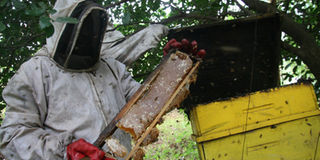Premium
All buzz about bees and cash I get from them

Justus Kiema harvesting honey during the interview on July 25, 2014. JENNIFER MUIRURI (NAIROBI) MERAB ELIZABETH
What you need to know:
- He gets the wax from traditional beehive farmers in West Pokot and in Eastern. Wax from traditional hives is the best because one can extract the honeycombs and cut them into pieces to make bee wax.
- For a farmer who ventures into apiculture for the first time, it will take them at least three months before their first harvest and afterwards, one harvests after every month.
As the sun set, paving the way for darkness, Justus Kiema strove to complete the task before it got dark.
He was harvesting honey at one of his clients’ farm in Karen, Nairobi.
Kiema was dressed in a bee suit and he was armed with a smoker and a brush. As he smoked the hive to immobilise the bees and lift the lid to access the honey combs, Kiema explained to his client:
“A beehive should not be left unattended for more than a month,” said Kiema, who trains farmers for free as long as one buys hives from him. Soon, he retrieved 10 wooden frames, which contained honeycombs filled with honey. He, thereafter, moved fast from the suspended hives in a zigzag manner.
The reason for the split-second action was to confuse the bees and prevent them from following the honey.
Kiema comes from a bee farming family in Kitui and he fell in love with the wonder insects early in life.
At one time in 2005 after helping his father harvest and sell 1,000kg of honey from his 50 beehives in Kitui, earning the family Sh120,000, Kiema saw the profitability of the venture.
But he decided to diversify into making hives as that is where he had seen a gap. To understand what he was about to venture into, he went to Mulango Technical Training College in Kitui for a woodwork craft course for one year.
“After leaving college in 2006, I kicked off the business,” said Kiema, who was supported by his parents to start the business. The owner of Royal Beekeepers recounted that his client base has expanded to an extent that at one time he made 217 hives for a single client. To make a beehive, Kiema uses timber, aluminum plates, plywood and shoe tacks.
“Maintaining the right temperature in the beehive is crucial. During the cold season, the bees will add propolis to close any openings which can make the hive cold.”
TRADITIONAL HIVES
He gets the wax from traditional beehive farmers in West Pokot and in Eastern. Wax from traditional hives is the best because one can extract the honeycombs and cut them into pieces to make bee wax.
He advised that a farmer should apply grease to aid in the prevention of sugar ants, which may attack the beehives.
“With good maintenance of an apiary and the beehives, a farmer can harvest up to 15kg of honey from a standard hive and 35kg from a jumbo hive.”
“A good honey box should have two chambers,” added Kiema, 30, who runs his workshop in Rongai, Nairobi.
The lower chamber houses the queen bee and the larvae while the upper chamber (which has a capacity of 20 honey frames) is used by the worker bees to produce honey. The two chambers are separated using a ‘‘queen excluder’’ of a 6mm width.
For a farmer who ventures into apiculture for the first time, it will take them at least three months before their first harvest and afterwards, one harvests after every month.
The father of one said that bees can be reared at any time of the year but advises that to attract more, a farmer should install empty hives one month before the rainy season, because during this period, bees fly away in search of dry places to shelter from the cold.
In his workshop he makes approximately 10 hives daily and up to 200 hives in a month and sells a standard hive at Sh4,000 while a jumbo hive goes for Sh5,000.
He has employed nine casual workers, who help him both in the workshop and on the farm where they buy the harvested honey from farmers at Sh500 a kilo. Making the hives is expensive because the price of timber has gone up.
The price of 10 by 1 inch timber has increased from Sh30 to Sh60 a foot. The 6 by 1 inch timber now sells for Sh30, up from Sh20 per foot.





